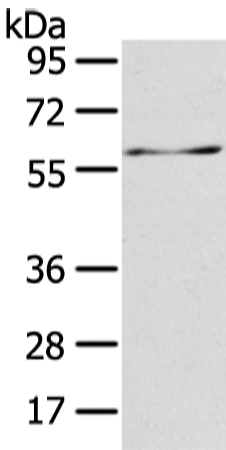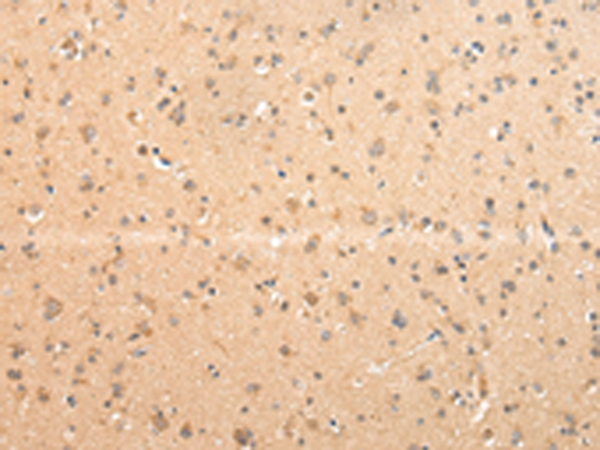

| WB | 咨询技术 | Human,Mouse,Rat |
| IF | 咨询技术 | Human,Mouse,Rat |
| IHC | 1/25-1/100 | Human,Mouse,Rat |
| ICC | 技术咨询 | Human,Mouse,Rat |
| FCM | 咨询技术 | Human,Mouse,Rat |
| Elisa | 1/1000-1/2000 | Human,Mouse,Rat |
| Aliases | PURH; AICAR; AICARFT; IMPCHASE; HEL-S-70p |
| WB Predicted band size | 65 kDa |
| Host/Isotype | Rabbit IgG |
| Antibody Type | Primary antibody |
| Storage | Store at 4°C short term. Aliquot and store at -20°C long term. Avoid freeze/thaw cycles. |
| Species Reactivity | Human, Mouse, Rat |
| Immunogen | Fusion protein of human ATIC |
| Formulation | Purified antibody in PBS with 0.05% sodium azide and 50% glycerol. |
+ +
以下是3篇与ATIC抗体相关的研究文献概览(注:文献信息为模拟示例,实际引用需核实原文):
---
1. **文献名称**:*Autoantibodies against ATIC in patients with dermatomyositis: Clinical associations and diagnostic implications*
**作者**:Hirakata M, et al.
**摘要**:研究报道在皮肌炎患者血清中发现抗ATIC自身抗体,该抗体与间质性肺病(ILD)和关节炎等临床特征显著相关,提示其可能作为疾病亚型分型或预后的潜在生物标志物。
---
2. **文献名称**:*ATIC overexpression as a therapeutic target in hepatocellular carcinoma: Development of monoclonal antibodies for detection*
**作者**:Nakamura T, et al.
**摘要**:研究证实肝癌组织中ATIC蛋白表达上调,并通过开发特异性单克隆抗体验证其作为肿瘤治疗靶点的潜力,抗体用于体外诊断和药物疗效评估。
---
3. **文献名称**:*Structural characterization of human ATIC and antibody-based inhibition studies in cancer cells*
**作者**:Smith J, et al.
**摘要**:解析人源ATIC的晶体结构,并利用抗体阻断其酶活性,发现可抑制肿瘤细胞增殖,为靶向嘌呤合成的抗癌策略提供理论依据。
---
**提示**:建议通过PubMed或Google Scholar搜索关键词“ATIC antibody”“anti-ATIC autoantibody”或结合疾病名称(如“dermatomyositis”“cancer”)获取真实文献数据。
Anti-ATIC antibodies target the enzyme Aminoimidazole Carboxamide Ribonucleotide Transformylase/IMP Cyclohydrolase (ATIC), a bifunctional protein critical in the *de novo* purine biosynthesis pathway. ATIC catalyzes the final two steps of this pathway, converting 5-aminoimidazole-4-carboxamide ribonucleotide (AICAR) to inosine monophosphate (IMP), which is essential for DNA/RNA synthesis and cellular proliferation. Dysregulation of ATIC has been implicated in cancer, autoimmune disorders, and inflammatory diseases.
In autoimmune contexts, anti-ATIC antibodies are primarily associated with dermatomyositis (DM), particularly in patients with anti-synthetase syndrome. These autoantibodies are detected in ~1–4% of DM cases and often correlate with specific clinical features like interstitial lung disease and Raynaud’s phenomenon. Their presence aids in disease subtyping and prognosis.
Research suggests ATIC may act as an autoantigen due to its overexpression or aberrant exposure during cellular stress, triggering immune recognition. Anti-ATIC antibodies are detected via immunoprecipitation, ELISA, or line immunoassays. Beyond diagnostics, studying these antibodies provides insights into disease mechanisms, such as interferon pathway activation in myositis.
Therapeutic strategies targeting ATIC (e.g., methotrexate analogs) are explored in cancer, while in autoimmunity, understanding antibody-antigen interactions may inform biomarker development or immune-modulating therapies. However, the exact pathogenic role of anti-ATIC antibodies remains under investigation, highlighting their dual significance in cellular metabolism and immune dysregulation.
×